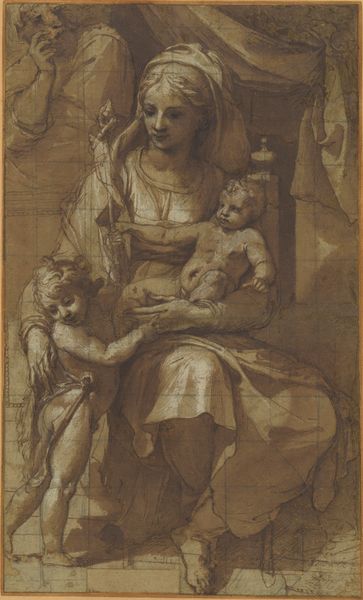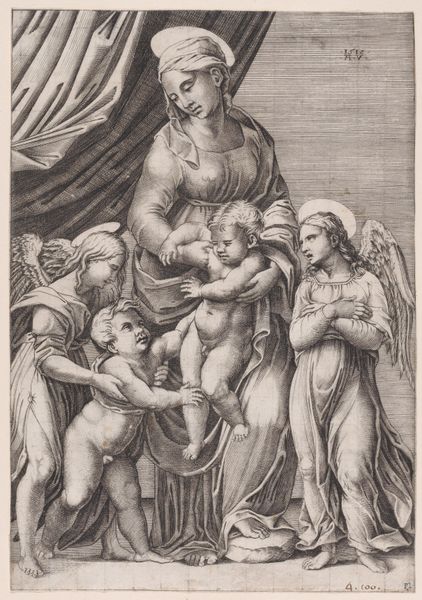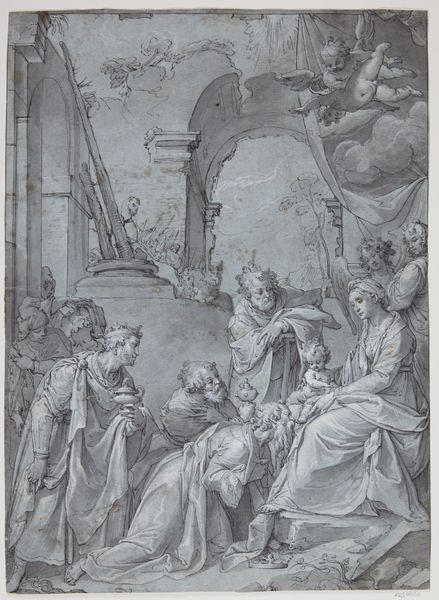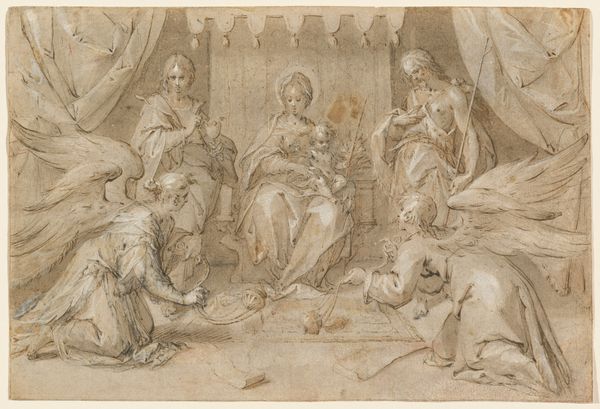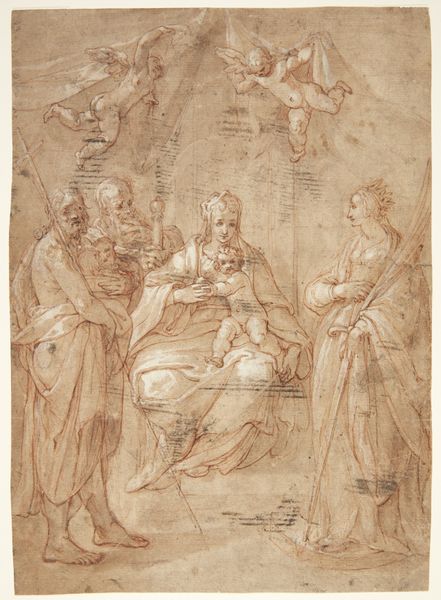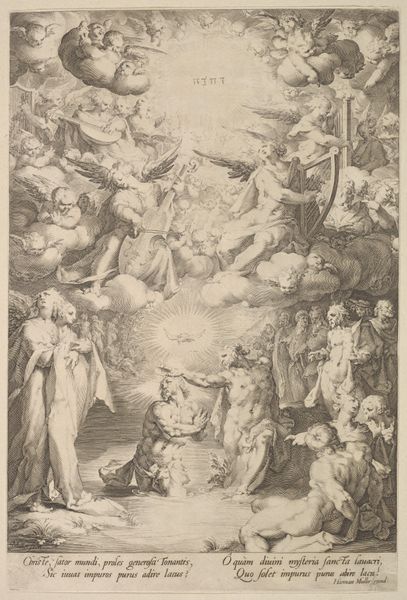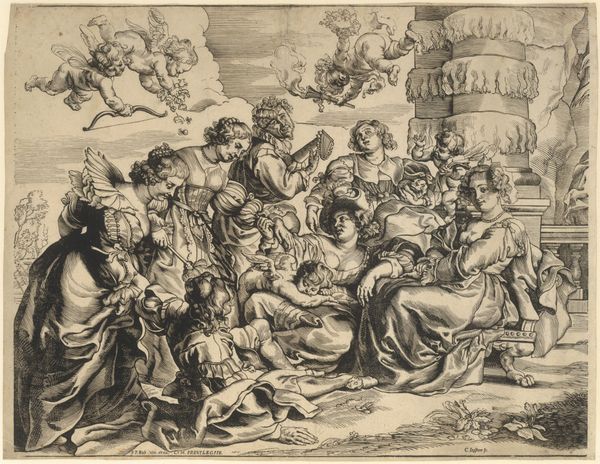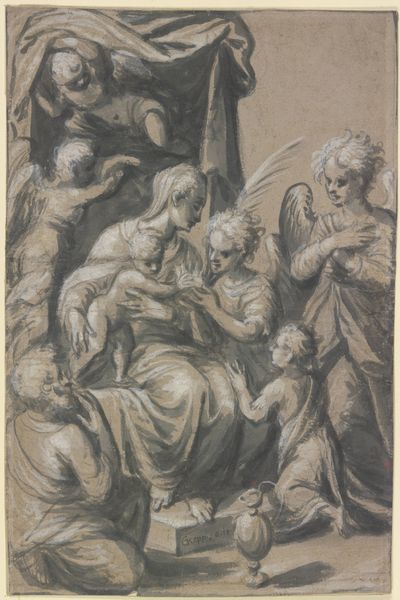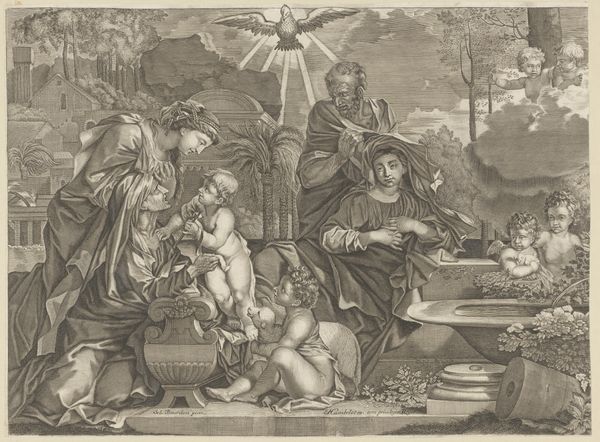
The Virgin Mary and Child, the Infant St.John and two angels 1552
0:00
0:00
painting, oil-paint, wood
#
portrait
#
painting
#
oil-paint
#
landscape
#
figuration
#
oil painting
#
underpainting
#
painting painterly
#
wood
#
history-painting
#
italian-renaissance
#
portrait art
#
fine art portrait
Dimensions: 51 cm (height) x 66.5 cm (width) (Netto)
Melchior Lorck created this oil painting depicting the Virgin Mary and Child with other figures, but its date remains unknown. Made in Northern Europe during the 16th century, this piece reflects the religious and artistic conventions of the time. The setting, architecture, and dress situate the holy figures in a contemporary European context rather than biblical Palestine. The inclusion of musical angels and St. John also draws on established visual codes of the Italian Renaissance. As a Northern European artist, Lorck's style shows the influence of Italian Renaissance ideals but with the aesthetic preferences of the North. The painting blends religious devotion with refined, worldly elegance, reflecting the tastes of the wealthy patrons who commissioned such works for private contemplation. To fully understand this painting, we can research the religious, artistic, and cultural norms that shaped its creation. These historical factors reveal the meaning of art as something deeply rooted in its social and institutional context.
Comments
statensmuseumforkunst almost 2 years ago
⋮
Ejerhistorie Ny viden om ejerhistorien har afsløret, at museet købte maleriet i Tyskland på en såkaldt jødeauktion i 1935 afholdt over industrimagnat og geheimeråd Ottmar Strauss’ kunstsamling. Maleriet var blandt kunstværkerne på én af de tre auktioner, som Ottmar Strauss afholdt over sin kunstsamling. For at få nazi-regimets tilladelse til at forlade Tyskland, blev jøder og efterkommere af jøder i 1934-35 tvunget til at afholde auktioner over deres ejendomme, indbo og kunstsamlinger. Alle indtægter fra auktionerne skulle overdrages til nazi-styret. Da Ottmar Strauss’ efterkommere i efteråret 2022 sporede Melchior Lorcks maleri til SMK anmodede de om at få maleriet leveret tilbage i henhold til Washington-principperne om nazi-konfiskeret kunst. Museet udskilte maleriet fra samlingen og afstod maleriet til efterkommerne. Det har både været deres og museets ønske, at Melchior Lorcks eneste kendte og bevarede maleri forblev i SMK’s samling. Museet generhvervede maleriet med støtte fra Hermod Lannungs Museumsfond og AFSMK (American Friends of SMK). Provenance New information regarding the painting’s provenance has revealed that the museum bought the painting in Germany at a so-called ‘Juden-Auktion’ (Jewish Sale) in 1935 of the art collection of industrial magnate and privy councillor Ottmar Strauss. The painting was among the works of art sold at one of three sales of Ottmar Strauss’s art collection. In order to obtain the Nazi regime’s permission to leave Germany, in 1934–35 Jews and descendants of Jews were forced to auction off their properties, possessions and art collections. All proceeds from these sales were to be handed over to the Nazi regime. When Ottmar Strauss’s descendants in autumn 2022 traced the Melchior Lorck painting to SMK, they requested that the painting be returned under the Washington Principles on Nazi-Confiscated Art. The museum elected to restitute the painting, returning ownership to Strauss’s heirs. At the same time, the heirs and the museum both wished to have the only known and preserved painting by Melchior Lorck remain part of the SMK collection. The museum subsequently re-acquired the painting with support from the Hermod Lannungs Museumsfond and AFSMK (American Friends of SMK).
Join the conversation
Join millions of artists and users on Artera today and experience the ultimate creative platform.
